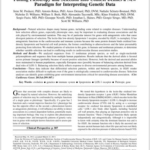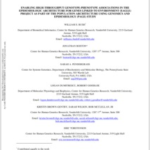Most body mass index (BMI) genetic loci have been identified in studies of primarily European ancestries. The effect of these loci in other racial/ethnic groups is less clear. Thus, we aimed to characterize the generalizability of 170 established BMI variants, or their proxies, to diverse US populations and trans-ethnically fine-map 36 BMI loci using a […]
Tag Archives: Genetics, Population
Putting pleiotropy and selection into context defines a new paradigm for interpreting genetic data.
Natural selection shapes many human genes, including some related to complex diseases. Understanding how selection affects genes, especially pleiotropic ones, may be important in evaluating disease associations and the role played by environmental variation. This may be of particular interest for genes with antagonistic roles that cause divergent patterns of selection. The lectin-like low-density lipoprotein […]
Putting pleiotropy and selection into context defines a new paradigm for interpreting genetic data.
Predazzi IM, Rokas A, Deinard A, Schnetz-Boutaud N, Williams ND, Bush WS, Tacconelli A, Friedrich K, Fazio S, Novelli G, Haines JL, Sirugo G, Williams SM,. Natural selection shapes many human genes, including some related to complex diseases. Understanding how selection affects genes, especially pleiotropic ones, may be important in evaluating disease associations and the […]
Enabling high-throughput genotype-phenotype associations in the Epidemiologic Architecture for Genes Linked to Environment (EAGLE) project as part of the Population Architecture using Genomics and Epidemiology (PAGE) study.
Genetic association studies have rapidly become a major tool for identifying the genetic basis of common human diseases. The advent of cost-effective genotyping coupled with large collections of samples linked to clinical outcomes and quantitative traits now make it possible to systematically characterize genotype-phenotype relationships in diverse populations and extensive datasets. To capitalize on these […]
Enabling high-throughput genotype-phenotype associations in the Epidemiologic Architecture for Genes Linked to Environment (EAGLE) project as part of the Population Architecture using Genomics and Epidemiology (PAGE) study.
Bush WS, Boston J, Pendergrass SA, Dumitrescu L, Goodloe R, Brown-Gentry K, Wilson S, McClellan B, Torstenson E, Basford MA, Spencer KL, Ritchie MD, Crawford DC,. Genetic association studies have rapidly become a major tool for identifying the genetic basis of common human diseases. The advent of cost-effective genotyping coupled with large collections of samples […]





